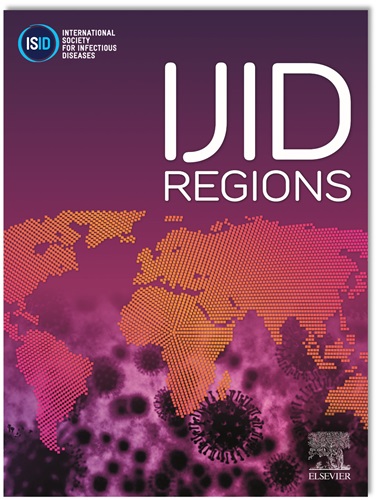Respiratory Tract Infections at Mass Gatherings
IF 4.8
2区 医学
Q1 INFECTIOUS DISEASES
引用次数: 0
Abstract
Introduction
Large-scale events that bring people together, like music festivals, athletic competitions, and religious pilgrimages, can foster the spread of respiratory pathogens by drawing large crowds of people in close quarters. Planning and implementing public health interventions and plans effectively requires an understanding of the dynamics and effects of RTIs in these contexts.
Methods
A thorough literature review was done to look at reports and studies about RTIs at large gatherings. Using electronic databases like PubMed, Scopus, and Google Scholar, pertinent articles were found. "Respiratory tract infections," "mass gatherings," "outbreaks," and associated keywords were among the search terms used. The review included studies that looked at the epidemiology, risk factors, transmission patterns, and interventions for RTIs in situations involving large crowds.
Results
The analysis produced a number of important conclusions. First off, respiratory viruses like influenza, respiratory syncytial virus (RSV), and coronaviruses are the main causes of RTIs, which are frequently observed during large crowds. Second, the quick spread of respiratory pathogens is facilitated by close contact between attendees, insufficient ventilation, and overcrowding. Third, elements including the length of the event, the type of activities, and the participants' demographics all have an impact on the risk of RTI transmission. Fourth, successful preventive initiatives have demonstrated encouraging outcomes in lowering the incidence of RTIs at large gatherings. These initiatives include vaccination campaigns, hand hygiene promotion, and respiratory etiquette.
Discussion
In order to lessen the impact of RTIs at large gatherings, it is crucial to conduct proactive surveillance, evaluate risks, and put preventive measures in place. Combining public health strategies like case isolation, early detection, and contact tracing can help manage outbreaks and reduce the spread of respiratory pathogens. Furthermore, the implementation of technology-driven monitoring platforms and crowd control techniques can facilitate the prompt detection and remediation of possible epidemics.
Conclusion
Since mass gatherings are high-density events, respiratory tract infections are a significant risk. To lessen the effects of RTIs and safeguard the public's and participants' health, thorough planning is necessary. This includes providing an appropriate healthcare infrastructure, communicating effectively, and implementing targeted preventive interventions. Subsequent investigations ought to concentrate on assessing the efficacy of interventions and improving tactics to augment respiratory infection control during large-scale assemblies.
引言 大型活动将人们聚集在一起,如音乐节、体育比赛和宗教朝圣活动,这些活动会吸引大量人群聚集在一起,从而促进呼吸道病原体的传播。要有效地规划和实施公共卫生干预措施和计划,就必须了解这些情况下的 RTIs 动态和影响。通过使用 PubMed、Scopus 和 Google Scholar 等电子数据库,我们找到了相关文章。搜索关键词包括 "呼吸道感染"、"大规模集会"、"爆发 "及相关关键词。综述包括对涉及大量人群的 RTIs 的流行病学、风险因素、传播模式和干预措施的研究。首先,流感、呼吸道合胞病毒(RSV)和冠状病毒等呼吸道病毒是导致 RTIs 的主要原因,而这些病毒在大型人群中经常出现。其次,与会者之间的密切接触、通风不足和过度拥挤都会促进呼吸道病原体的快速传播。第三,活动时间长短、活动类型和参与者的人口统计学特征等因素都会影响 RTI 传播的风险。第四,成功的预防措施在降低大型集会的 RTI 发病率方面取得了令人鼓舞的成果。这些措施包括疫苗接种活动、手部卫生宣传和呼吸道礼仪。讨论 为了减少 RTI 在大型集会中的影响,关键是要进行前瞻性监测、评估风险并制定预防措施。结合病例隔离、早期检测和接触者追踪等公共卫生策略,有助于控制疫情爆发和减少呼吸道病原体的传播。此外,实施技术驱动的监测平台和人群控制技术可促进及时发现和补救可能发生的流行病。为了减轻呼吸道感染的影响,保障公众和参与者的健康,必须进行周密的规划。这包括提供适当的医疗保健基础设施、有效沟通和实施有针对性的预防干预措施。后续调查应集中于评估干预措施的效果和改进策略,以加强大型集会期间的呼吸道感染控制。
本文章由计算机程序翻译,如有差异,请以英文原文为准。
求助全文
约1分钟内获得全文
求助全文
来源期刊
CiteScore
18.90
自引率
2.40%
发文量
1020
审稿时长
30 days
期刊介绍:
International Journal of Infectious Diseases (IJID)
Publisher: International Society for Infectious Diseases
Publication Frequency: Monthly
Type: Peer-reviewed, Open Access
Scope:
Publishes original clinical and laboratory-based research.
Reports clinical trials, reviews, and some case reports.
Focuses on epidemiology, clinical diagnosis, treatment, and control of infectious diseases.
Emphasizes diseases common in under-resourced countries.

 求助内容:
求助内容: 应助结果提醒方式:
应助结果提醒方式:


